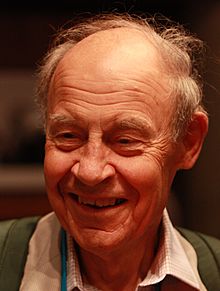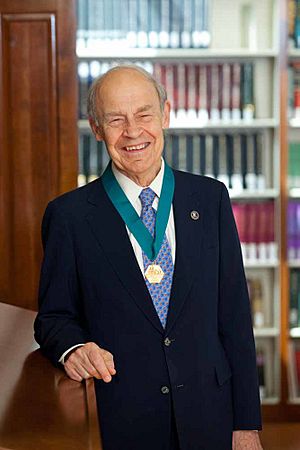Dudley R. Herschbach facts for kids
Quick facts for kids
Dudley R. Herschbach
|
|
|---|---|

Herschbach in 2012
|
|
| Born |
Dudley Robert Herschbach
June 18, 1932 San Jose, California, U.S.
|
| Alma mater | Stanford University (BS, MS) Harvard University (MA, PhD) |
| Known for | Molecular dynamics |
| Awards | ACS Award in Pure Chemistry (1965) Linus Pauling Medal (1978) RSC Michael Polanyi Medal (1981) Irving Langmuir Award (1983) Nobel Prize in Chemistry (1986) National Medal of Science (1991) American Institute of Chemists Gold Medal (2011) |
| Scientific career | |
| Fields | Chemistry |
| Institutions | University of California, Berkeley Harvard University Freiburg University Texas A&M University |
| Doctoral advisor | Edgar Bright Wilson |
| Doctoral students | Richard N. Zare Seong Keun Kim Timothy Clark Germann |
Dudley Robert Herschbach (born June 18, 1932) is an American chemist. He taught at Harvard University for many years. In 1986, he won the Nobel Prize in Chemistry. He shared this award with Yuan T. Lee and John C. Polanyi. They won for their work on how chemical reactions happen at a very basic level.
Herschbach and Lee focused on using "molecular beams." They did special experiments called crossed molecular beam experiments. This helped them understand how tiny particles react with each other. Herschbach is also part of the Board of Sponsors for the Bulletin of the Atomic Scientists.
Contents
Early Life and School
Dudley Herschbach was born in San Jose, California. This was on June 18, 1932. He was the oldest of six children. He grew up in the countryside.
He went to Campbell High School. There, he played football. He was offered scholarships for both sports and academics at Stanford University. He chose the academic path.
At Stanford, he studied chemistry. He earned a Bachelor of Science (B.S.) degree in mathematics in 1954. He then got a Master of Science (M.S.) degree in chemistry in 1955.
After Stanford, Herschbach went to Harvard University. He earned a Master of Arts (A.M.) degree in physics in 1956. He then completed his Doctor of Philosophy (Ph.D.) in chemical physics in 1958. His research at Harvard involved studying molecules using special tools.
Amazing Discoveries in Chemistry
In 1959, Herschbach started working at the University of California at Berkeley. He became a chemistry professor there. He and his students built a large machine. This machine helped them study how atoms and molecules react when they crash into each other.
Many people thought that these tiny particles wouldn't collide in a useful way. But Herschbach proved them wrong! His experiments showed how chemical reactions really happen. For example, he studied how potassium (K) reacts with methyl iodide (CH3I). He saw that the products bounced directly away from the incoming potassium atom.
Later, he studied potassium (K) and bromine (Br2). He found that the way they reacted was different. The products scattered forward from the incoming potassium atom. This work helped scientists connect the structure of chemicals to how they react.
The Nobel Prize-Winning Work
In 1963, Herschbach returned to Harvard University. He continued his work on how molecules react. In 1967, another scientist named Yuan T. Lee joined his lab. Together, they built an even more advanced machine. This "supermachine" helped them study complex reactions.
Their most famous work was on "crossed molecular beam experiments." This is what won them the Nobel Prize in Chemistry in 1986. They shared the prize with John C. Polanyi.
Imagine two very thin streams of gas. These streams cross each other in a vacuum. When the molecules in these streams collide, they react. Herschbach and Lee's experiments allowed them to see exactly how energy was shared among the new molecules formed. This was a huge step in understanding how chemical reactions work. Their work helped create a whole new area of study in chemistry.
Herschbach also studied how the spinning motion of molecules affects reactions. This is called molecular stereodynamics.
Throughout his career, Herschbach has written over 400 scientific papers. He has used his knowledge of chemistry and physics to solve many different problems. For example, he studied how methane can form deep inside the Earth. This suggests that there might be more natural gas on Earth than we thought. It means not all hydrocarbons come from fossil fuels.
Science and Education
Dudley Herschbach loves teaching science. He taught many different courses, from advanced classes to basic chemistry for new college students. He said teaching the introductory course was his "most challenging assignment."
He strongly believes that everyone should learn about science. He often gives talks to students of all ages. He shares his excitement for science and discovery. He even appeared on the animated TV show The Simpsons. In one episode, he presented the Nobel Prize in Physics to Professor Frink.
In 2010, Herschbach met with middle and high school students. This was part of the USA Science and Engineering Festival. Students could have lunch and talk informally with him. He is also on the festival's advisory board. He has also given lectures at the Research Science Institute (RSI). This is a summer research program for high school students at MIT.
Even though he is a professor emeritus at Harvard, he still teaches. Since 2005, he has taught one semester a year at Texas A&M University. He is still well-known for his teaching and mentoring at Harvard. He and his wife, Georgene Herschbach, also used to be leaders at Currier House. This is a student residence at Harvard. They were very involved in student life there.
Public Service
Dudley Herschbach is involved in many important groups. He is on the board of the Center for Arms Control and Non-Proliferation. He also led the Society for Science & the Public for many years. This group helps promote science education. He is also on the Board of Sponsors for the Bulletin of the Atomic Scientists. In 2003, he was one of 22 Nobel winners who signed the Humanist Manifesto.
He is also an Eagle Scout. This is the highest rank in the Boy Scouts of America. He also received the Distinguished Eagle Scout Award.
Family
Dudley Herschbach's wife is Georgene Herschbach. She was an Associate Dean at Harvard College. She helped manage academic programs for students. Before she retired in 2009, she led a committee that focused on undergraduate education.
Awards and Honors
Dudley Herschbach is a member of many important groups. These include the American Academy of Arts and Sciences and the National Academy of Sciences. Besides the Nobel Prize, he has won many other awards. These include the National Medal of Science, the Linus Pauling Medal, and the American Institute of Chemists Gold Medal.
He even created his own award, the Herschbach Medal. This medal is given to scientists who make great contributions to the study of molecular collisions.
See also
 In Spanish: Dudley Robert Herschbach para niños
In Spanish: Dudley Robert Herschbach para niños


